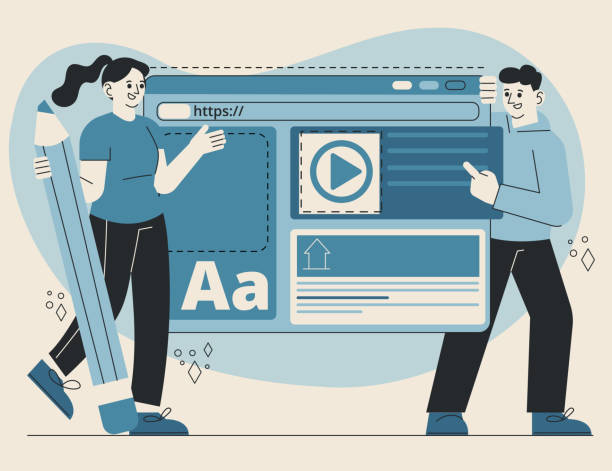Introduction to Website Design with a Modern User Interface

In today’s digital world, where competition for user attention intensifies moment by moment, the importance of website design with a modern user interface is more apparent than ever.
This type of design is not just about visual aesthetics, but beyond that, it encompasses interactivity, efficiency, and a smooth user experience.
A modern user interface transforms your website into a powerful tool for connecting with your audience.
This chapter, in an #educational and #explanatory manner, introduces this vital concept and clarifies its importance for the success of online businesses and user satisfaction.
User-friendliness and intuitive navigation are two main pillars of this design approach, directly impacting user retention and conversion rates.
When users can easily find what they need and interact with your website, the likelihood of their return and conversion into loyal customers increases.
In fact, User Interface (UI) is a bridge between the user and the system, and the stronger and more beautiful this bridge, the more effective the communication will be.
The use of readable fonts, sufficient white space, and logical arrangement of elements all contribute to enhancing this experience.
The ultimate goal of this type of design is to create a seamless user experience where the user not only meets their needs but also enjoys interacting with the website.
This approach enables businesses to have a stronger and more effective online presence.
Are you dissatisfied with the low conversion rate of visitors to customers on your e-commerce site?
Solve this problem forever with professional e-commerce website design by Rasavab!
✅ Increase visitor to customer conversion rate
✅ Create an excellent user experience and gain customer trust
⚡ Get free consultation
Key Principles in Modern User Interface Design
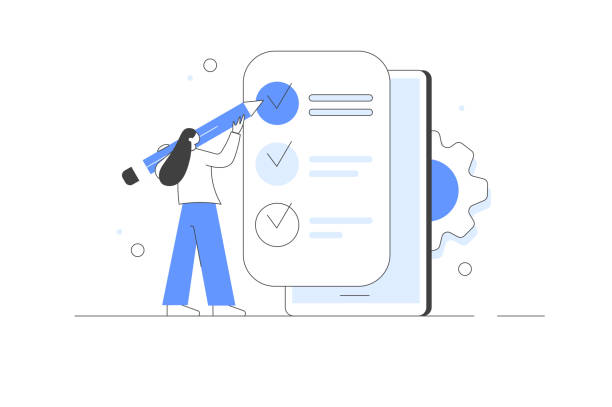
To achieve a modern and efficient user interface, adherence to specific principles and fundamentals is essential.
These principles, which act as the backbone of a successful design, include vital elements such as user-centricity, simplicity, consistency, rapid feedback, and efficiency.
A user-centric design means that all design decisions should be made considering user needs and behaviors.
Simplicity means removing unnecessary elements and presenting information in the clearest possible way, so that the user reaches their goal without confusion.
Consistency emphasizes the importance of harmony in the appearance and functionality of all parts of the website; for example, Call-to-Action (CTA) buttons should look similar and have similar functionality across all pages.
Rapid feedback assures the user that their operation has been successful or requires correction, for instance, by displaying a clear confirmation or error message.
Efficiency also means that users can accomplish their tasks in the shortest time and with the least effort.
All these principles ultimately lead to the creation of an enjoyable and effective user experience.
This section, in a #guidance and #expert manner, elaborates on each of these principles and demonstrates how their combination can contribute to advanced user interface website design that is not only beautiful but also truly useful and practical for users.
Ultimately, the goal is to create an unforgettable experience that encourages users to return.
The Role of User Experience (UX) in Modern Design

In the world of web design, User Interface (UI) and User Experience (UX) are two inseparable concepts that, while distinct, complement each other.
UX focuses on the overall feeling and experience of the user when interacting with a product or system, while UI deals with its appearance and visual elements.
This section, in an #analytical and #thought-provoking manner, delves into the critical role of UX in the success of website design with a modern user interface.
A good UX is built upon thorough user research, needs analysis, mapping user journeys, and designing wireframes and prototypes.
Without a strong UX foundation, even the most beautiful UI cannot keep users satisfied.
If the user interface is the face of the website, user experience is its soul.
A website might appear attractive with outstanding UI design, but if users cannot easily navigate it, find the information they need, or achieve their goals, they will eventually leave.
UX research helps identify user pain points and opportunities for improvement.
This continuous optimization process ensures that the website is not only beautiful but also truly useful and efficient.
The synergy between these two areas transforms the website into a powerful tool for attracting and retaining an audience.
Understanding user needs and designing solutions that intuitively and pleasantly meet these needs is the core of a strong UX, directly impacting the quality of the final UI.
| Feature | User Interface (UI) | User Experience (UX) |
|---|---|---|
| Primary Focus | Appearance and Feeling (How it looks) | Feeling and Functionality (How it feels) |
| Design Elements | Buttons, Icons, Colors, Fonts, Images | User Journey, Information Hierarchy, Interactivity |
| Goal | Visual Appeal and Ease of Interaction | User Satisfaction and Problem Solving |
| Process | Visual Design, Interaction Design | User Research, Wireframing, Prototyping, Testing |
Modern Tools and Technologies in Web Design

The world of web design is rapidly evolving, with new tools and technologies constantly being introduced to facilitate and improve the process of designing modern websites with attractive UIs.
This section, in an #expert and #educational manner, introduces some of the most important tools and frameworks that are at the heart of every modern design.
In the visual design phase, software like Figma, Sketch, and Adobe XD are leading.
These tools enable rapid design, interactive prototyping, and team collaboration.
In the front-end development section, JavaScript frameworks and libraries such as React.js, Vue.js, and Angular empower developers to build complex and dynamic user interfaces with high performance.
These frameworks significantly accelerate the development process by providing reusable components and optimized state management.
Furthermore, the use of CSS preprocessors like Sass and Less helps in better organizing CSS code and creating more maintainable stylesheets.
Design Systems have also become an essential tool in large companies, ensuring consistency across all products.
These technologies not only help designers create beautiful websites but also enable them to deliver websites with excellent performance, fast loading, and an unparalleled user experience.
The right choice of these tools and technologies can make a significant difference in the final product quality and development speed.
Are you tired of your e-commerce site having visitors but no sales? Rasavab solves your main problem with professional e-commerce website design!
✅ Significant sales increase with targeted design
✅ Seamless user experience for your customers
⚡ Get free consultation!
Challenges and Solutions for Responsive Design

In the current era, where internet access through various devices including smartphones, tablets, and desktops has become common, Responsive Design has become an indispensable necessity.
This chapter, in an #explanatory and #guidance manner, examines the main challenges in implementing responsive design and provides effective solutions for them.
The goal of responsive design is to ensure that your website has an optimal appearance and excellent performance on any screen size, which is vital for a website design with a modern user interface.
One of the biggest challenges is ensuring a consistent user experience across different devices.
This requires a “Mobile-First” approach; meaning starting the design for the smallest screen and then scaling up to larger devices.
Using Fluid Grids, Flexible Images, and Media Queries in CSS are key tools to achieve this goal.
Another challenge is managing website performance on mobile devices, which often have less bandwidth and limited processing power.
Optimizing images, reducing CSS and JavaScript code, and using a CDN (Content Delivery Network) can help improve loading speed.
Also, challenges related to touch interaction versus mouse and keyboard interaction should be considered so that buttons and interactive elements are sufficiently large and accessible.
By overcoming these challenges, one can ensure that the website not only looks beautiful on any device but also offers flawless performance and a smooth experience to users, thus making responsive web design the fundamental basis of a successful design.
The Importance of Aesthetics and Visuals in User Attraction

Aesthetics and visual elements play a pivotal role in initially attracting users and creating a lasting impression.
In fact, the beauty of a website is the first thing that captivates a user and encourages them to explore further.
This section, in an #entertaining and #analytical manner, deeply examines the importance of these elements in the success of a modern UI website design.
The correct choice of color palette, readable and pleasing fonts (typography), and intelligent use of White Space all contribute to creating a delightful visual experience.
Visual Hierarchy helps the user quickly identify and understand important information.
The psychology of colors also holds great importance here; each color can evoke different emotions and convey a specific message.
For example, blue usually evokes a sense of trust and calmness, while red can be exciting and energetic.
Images and icons must also be high-quality, relevant to the content, and consistent in style to help reinforce the visual message.
A strong visual design not only brings beauty but also increases efficiency; a beautiful and attractive user interface makes navigation more intuitive and interaction more enjoyable.
When a website is visually organized and pleasing, the user feels more comfortable and trusting, and spends more time on it.
These visual elements alone can make the difference between a forgettable website and a memorable experience.
Examining Future Trends in User Interface Design
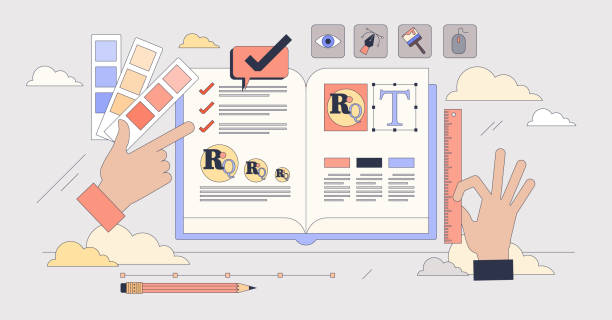
The world of user interface design is constantly changing and evolving, with new trends rapidly emerging.
Forecasting and understanding these trends are crucial for web designers aiming to deliver modern and cutting-edge website UI design.
This chapter, in a #news and #thought-provoking format, examines some of the most important future trends that are set to shape the future of UI.
One of the most prominent trends is the increasing use of Dark Mode, which is not only beneficial for reducing eye strain in low-light environments but also gives websites a modern and stylish look.
Voice User Interfaces (VUI) are also expanding with the advancement of voice assistants like Siri and Alexa, and websites and applications are moving towards voice interactions.
The use of Artificial Intelligence (AI) in design, such as tools that automatically optimize layouts or personalize content, is also growing.
Micro-interactions, which are small, subtle animations that provide feedback to users and make the experience more enjoyable, have gained increasing importance.
Augmented Reality (AR) and Virtual Reality (VR) are also gradually finding their way into web experiences, providing new possibilities for immersive interactions.
Alongside these, Motion Design and more complex animations will play a more prominent role in creating visual storytelling and increasing appeal.
These trends indicate that the future of UI will not only be visual and interactive but also increasingly intelligent, immersive, and personalized.
| Emerging Trend | Description | Impact on User Experience |
|---|---|---|
| Dark Mode | User interface with dark background and light text | Reduced eye strain, lower battery consumption, modern aesthetic |
| Voice User Interface (VUI) | Interaction with the system via voice commands | Increased accessibility, more natural interaction, hands-free use |
| Micro-interactions | Small and subtle animations for user feedback | Increased enjoyment, improved navigation, reduced confusion |
| Augmented Reality (AR) in Web | Integration of virtual elements with the real world via browser | Interactive shopping experience, immersive education, 3D product display |
SEO and Optimization in Website Design with a Modern User Interface

Website design with a modern user interface is not limited to aesthetics and user experience; it also has a deep connection with Search Engine Optimization (SEO).
This section, in an #expert and #guidance manner, discusses how a good UI can help improve a website’s ranking in search results.
Search engines like Google are increasingly focusing on user experience as a ranking factor.
Page loading speed is one of the most important factors; an optimized and lightweight user interface leads to faster website loading, which not only improves user experience but is also favored by search engines.
Responsive design and mobile compatibility are also critical SEO factors; websites that do not display well on various devices will rank lower in search results.
Bounce Rate and Dwell Time are also important metrics directly influenced by UI and UX quality.
An attractive UI and intuitive navigation encourage the user to spend more time on the site and visit more pages, sending positive signals to search engines.
Furthermore, the correct use of semantic HTML tags, optimized URL structure, and the use of images with appropriate Alt-text, although not part of the UI, significantly help improve SEO alongside a modern UI.
Therefore, investing in website design with a modern user interface not only improves user experience but also indirectly leads to increased website visibility in search engines.
Did you know that poor online store design can drive away up to 70% of your potential customers? Rasavab revolutionizes your sales with professional and user-friendly e-commerce website design.
✅ Significant increase in sales and revenue
✅ Full optimization for search engines and mobile
⚡ [Get free consultation from Rasavab]
Case Study of Successful Projects with Modern UI
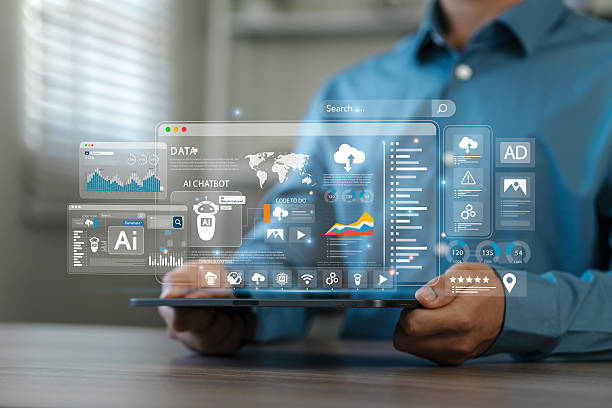
To gain a deeper understanding of the principles and applications of website design with a modern user interface, nothing is better than examining successful examples.
This section, in an #analytical and #educational manner, examines several websites or applications known for their modern and outstanding UI, highlighting their key success elements.
For example, websites like Airbnb with minimalist design and high-quality images, or Slack with a clean and efficiency-focused user interface, are prime examples of modern UI.
How did these projects achieve such success? One common factor is an unwavering focus on the user.
They not only look beautiful but are also amazingly functional and easy to use.
The use of limited but effective color palettes, readable typography, and sufficient white space to create focus and visual calm are common features among them.
Additionally, these websites utilize smart micro-interactions to provide user feedback and improve workflow.
Navigation on these sites is highly intuitive, and users can easily achieve their goals.
A mobile-first approach and responsive design are also well-implemented in all these examples, ensuring a consistent experience across all devices.
These case studies demonstrate that a modern UI is more than just visual aesthetics; it’s an artistic combination of beauty, efficiency, and usability that ultimately leads to user satisfaction and loyalty.
These examples inspire designers and developers to create better digital experiences.
Step-by-Step Guide to Starting Website Design with a Modern User Interface
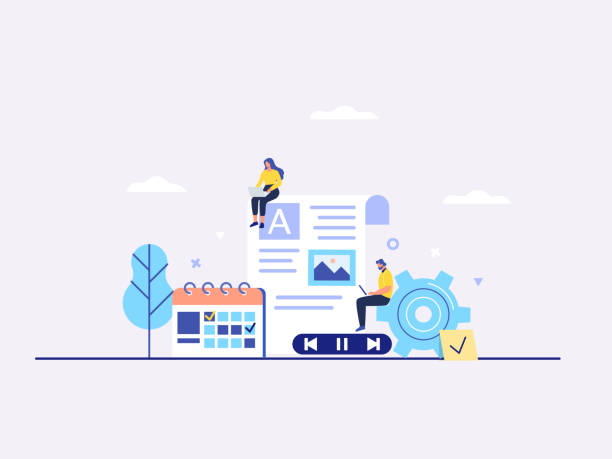
Starting the journey in the world of modern UI website design might seem daunting at first, but with a step-by-step and systematic approach, success can be achieved.
This chapter, in a #guidance and #educational manner, provides a practical roadmap for those interested in this field.
First, understanding user needs and project goals is essential.
User research, interviews with potential users, and competitor analysis provide a strong foundation for design.
Following that is the stage of Wireframing and Prototyping.
In this step, initial layouts and page arrangements are designed without focusing on visual details, to test the user flow and overall functionality.
Then, it’s time for Visual Design, which includes selecting the color palette, fonts, icons, and images.
In this stage, the aesthetic and visual principles discussed earlier are applied.
After completing the design, front-end implementation and development begin.
In this stage, HTML, CSS, and JavaScript codes are written to transform visual designs into a functional and interactive website.
Finally, continuous testing and optimization are of high importance.
Gathering feedback from real users and conducting A/B tests can help identify weaknesses and continuously improve the user experience.
This is an iterative process, with each cycle bringing the final product closer to perfection.
Also, continuous monitoring of new trends and learning up-to-date tools and technologies are vital for long-term success in this field.
Frequently Asked Questions
| Row | Question | Answer |
|---|---|---|
| 1 | What does Modern UI in website design mean? | Modern UI means designing websites with a minimalist appearance, extensive use of white space, clear typography, vibrant colors or consistent palettes, subtle animations, and a focus on visual and intuitive user experience (UX). |
| 2 | What features make a user interface ‘modern’? | Key features include responsive design, smooth animations, use of vectors and SVG icons, prominent typography, sufficient white space, creative layering, harmonious colors, and a focus on accessibility. |
| 3 | What is the importance of Responsive Design in modern UI? | Responsive design ensures that the website displays correctly on any device (mobile, tablet, desktop) and provides a consistent user experience, which is one of the fundamental principles of modern UI. |
| 4 | Why is the use of White Space important in modern design? | White space, or ‘negative space’, helps text and other elements breathe and stand out, increases readability, enhances user focus on the main content, and creates a clean, professional appearance. |
| 5 | What is the role of animations and micro-interactions in modern UI? | Animations and micro-interactions (small interactions) make the user experience more dynamic and engaging, provide feedback to the user, improve navigation flow, and add a sense of quality and polish to the design. |
| 6 | What is the place of typography in modern website design? | Typography plays a very important role in modern design; appropriate fonts, size, weight, and correct spacing improve readability and can convey a specific mood and personality to the brand. |
| 7 | How can visual consistency be achieved in modern design? | By using a Design System, a limited and specific color palette, consistent typography, reusable UI components, and maintaining uniformity in spacing between elements and visual rhythm. |
| 8 | What is the relationship between User Experience (UX) and modern User Interface (UI)? | User Interface (UI) is the visual and interactive part of a product, while User Experience (UX) relates to the user’s overall feeling when using the product. A modern UI should contribute to improving UX and be functional and intuitive beyond just visual appeal. |
| 9 | What are some common trends in modern UI design? | Trends include Dark Mode, Neumorphism, Glassmorphism, large and prominent typography, use of gradients, 3D images, and Lottie animations. |
| 10 | What are the main challenges in designing a website with a modern user interface? | Challenges include maintaining simplicity while innovating, ensuring Accessibility, optimizing loading speed despite heavy animations and images, and maintaining a balance between aesthetics and functionality. |
And other services of Rasavab Advertising Agency in the field of advertising
Smart UI/UX: A new service to enhance campaign management through custom programming.
Smart Advertising Campaign: A new service to enhance customer behavior analysis through precise audience targeting.
Smart Custom Software: Designed for businesses seeking to analyze customer behavior through optimizing key pages.
Smart Sales Automation: An effective tool to increase sales with the help of Google Ads management.
Smart Sales Automation: A combination of creativity and technology for campaign management through attractive user interface design.
And over hundreds of other services in internet advertising, advertising consultation, and organizational solutions
Internet Advertising | Advertising Strategy | Advertorial
Sources
- Article: Modern Approach to Website Design
- Blog: The Importance of User Interface in the Web World
- Guide: New Developments in Web Design
- Services: User Experience (UX) Optimization
? To elevate your business in the digital world, Rasavab Afarin, with its comprehensive and specialized services including custom website design, SEO, and content marketing, smooths your path to growth. Experience a powerful and targeted online presence with us.
📍 Tehran, Mirdamad Street, next to Central Bank, Kazeroun Jonoubi Alley, Ramin Alley, No. 6


